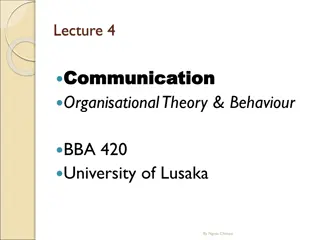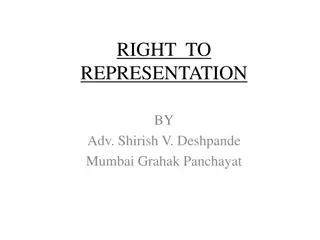
Utility Analysis in Economics
Delve into utility analysis with topics such as cardinal and ordinal approaches, indifference curves, assumptions, and more. Learn about the measurement of utility and its significance in consumer behavior. Enhance your knowledge of economic concepts through detailed insights and examples.
Download Presentation

Please find below an Image/Link to download the presentation.
The content on the website is provided AS IS for your information and personal use only. It may not be sold, licensed, or shared on other websites without obtaining consent from the author. If you encounter any issues during the download, it is possible that the publisher has removed the file from their server.
You are allowed to download the files provided on this website for personal or commercial use, subject to the condition that they are used lawfully. All files are the property of their respective owners.
The content on the website is provided AS IS for your information and personal use only. It may not be sold, licensed, or shared on other websites without obtaining consent from the author.
E N D
Presentation Transcript
Utility Analysis Sarika Singh FMS MLSU Udaipur
I. Introduction to Utilityanalysis Meaning of Utility - The power of a commodity that satisfy the wantsof consumer - want satisfyingpower Introduced by JermyBentham Measurement Utils Subjectiveentity
II. Cardinal Utility approach and Ordinal Utility lapproach Utility Analysis Cardinal Utilityanalysis Ordinal UtilityAnalysis AlfredMarshal J. R. Hicks & R.G.D.Allen Cannot be measured butcompared can be measured asrank Utils Law of DiminishingMarginal Indifference Curveanalysis Utility Law of Equi-marginalUtility MashellianAnalysis
III. Meaning of Ordinal Utilityanalysis and itsassumptions Meaning of Ordinal Utilityanalysis Ordinal means- Can be compare with each other- 1St , 2nd , 3rdetc. Ordinal Utility analysis - Utility can compare but can not bemeasure. Popularized by J.R. Hicks and R.G.D.Allen Used the tool named IndifferenceCurve Known as Indifference curve approach of utility analysis
III. Assumption of Cardinal Utility Analysis or Indifference Curveapproach 1. Consumer is rational or Rationality: Consumer s Objective is maximization of utility, subject to Price andconsumption expenditure 2. Utility isordinal: Utility cannot be measured cardinally. It can be expressed ordinally can rank according to the satisfactionor utility of eachbasket. 3. Consistence in choice: if the consumerpreferscombinationsofAof goodto the combinationsBof goods, he then remains consistent in hischoice. If A > B, then never become B > A
III. Assumption of Cardinal Utility Analysis or Indifference Curveapproach 4. Consumer sPreferenceisTransitive: A is preferred over combination B is preferred over C, then combination A is preferred over combination A is preferred overC. If A > B and B > C, then A > C 5. Diminishing Marginal Substitution of goods: In the Indifference Curve analysis, the principle of Diminishing Marginal Rate of Substitution is assumed.That isConvexity of Indifference curve or Negative slop of indifference 6. DependentUtility: TU = f( q1 + q2 + q3 + . . . . . .+qn) 7. A Large bundle of goods preferredto smallbundle
IV. Meaning of IndifferenceCurve The Indifference curve was invented by F Y Edgeworth An Indifference curve is the locus point of all those combination of two commodity that yield same level of satisfaction or utility to the consume
IV. Meaning of IndifferenceCurve An Indifference curve is the locus point of all those combination of two commodity that yield same level of satisfaction or utility to the consumer VariousCombinations: Utility Combination Unit of Rice Unit of Wheat 16 kg of Rice 2 kg of Wheat 100u a) 12 kg of Rice 5 kg of Wheat 100u b) 11 kg of Rice 7 kg of Wheat 100u c) 10 kg of Rice 10 kg of Wheat 100u d) 9 kg of Rice 15 kg of Wheat 100u e)
IV. Meaning of IndifferenceCurve VariousCombinations: Utility Unitof Wheat Unit ofRice 16 2 100u a 12 5 100u b 11 7 100u c 10 10 100u d 9 15 100u e An Indifference curve is the locus point of all those combination of two commodity that yield same level of satisfaction or utility to the consumer
An IndifferenceMap A graph showing a whole set of indifference curves is called an indifference map.An indifference map, in other words, is comprised of a set of indifference curves. Each successive curve further from the original curve indicates a higher level of total satisfaction.
VI. Marginal Rate of Substitution of goods MRSxy The concept of Marginal Rate Substitution (MRS) was introduced by Dr. J.R. Hicks and Prof. R.G.D. Allento takethe placeof the concept of diminishing marginalutility. The slop of indifference curve is known as Marginal Rate of SubstitutionMRS The rate or ratio at which goods X and Y are to be exchanged is known as the marginal rate of substitution (MRS). The marginal rate of substitution of X for Y measures the number of units of Y that must be scarified for one unit of X gained so as to maintain a constant levelof satisfaction . MRS xy = Change in good X / Changes in goodY - MRS xy=
VI. Marginal Rate of Substitution of goods MRSxy MRS : The marginal rate of substitution of X for Y measures the number ofunits of Y that must be scarified for unit of X gained so as to maintain a constant levelof satisfaction . MRS xy = Change in good X / Changes in goodY - MRS xy= Combination Apple X MangoY Utility Ratio MRS A B C D E 1 2 3 4 5 15 10 6 3 1 100 100 100 100 100 - - 5 4 3 2 5:1 4:1 3:1 2:1
VI. Marginal Rate of Substitution of goods MRS xy MRS : The marginal rate of substitution of X for Y measures the number ofunits of Y that must be scarified for one unit of X gained so as to maintain a constant level of satisfaction . MRS xy = Change in good Y / Changes in goodX - MRS xy =
VI. Marginal Rate of Substitution of goods MRSxy MRS : The marginal rate of substitution of X for Y measures the number ofunits of Y that must be scarified for unit of X gained so as to maintain a constant levelof satisfaction . MRS xy = Change in good X / Changes in goodY - MRS xy= Combination A B C D E Apple X 2 4 6 8 10 MangoY 30 20 12 Ratio MRS 6 2
VI. Marginal Rate of Substitution of goods MRSxy MRS : The marginal rate of substitution of X for Y measures the number ofunits of Y that must be scarified for unit of X gained so as to maintain a constant levelof satisfaction . MRS xy = Change in good X / Changes in goodY - MRS xy= Combination A B C D E Apple X 2 4 6 8 10 MangoY 30 20 12 Ratio MRS - - 5 4 3 2 10:2 8:2 6:2 4:2 6 2
VII. Principles of Diminishing Marginal Rate of Substitution of goods MRSxy This behaviour showing falling MRS of good X for good Y and yet to remain at thesame level of satisfaction is known as Diminishing Marginal Rate ofSubstitution. Combination A B C D E Apple X 1 2 3 4 5 MangoY 15 10 MRS - 5 4 3 2 6 3 1
V. Properties/Characteristics of IndifferenceCurve (1) Indifference Curves are NegativelySloped: It slopes downward because as the consumer increases the consumption of X commodity,he has to give up certain units of Y commodity in order to maintain the same level of satisfaction.
V. Properties/Characteristics of IndifferenceCurve (2) Indifference Curve are Convex to theOrigin: the consumer substitutes commodity X for commodity Y, the marginal rate of substitution diminishes of X for Y along an indifference curve. Principle of Diminishing Marginal Rateof Substitution
V. Properties/Characteristics of IndifferenceCurve (3) Higher Indifference Curve Represents HigherLevel A higher indifference curve that lies above and to the right of anotherindifference curve represents a higher level of satisfaction and combination on a lower indifference curve yields a lowersatisfaction.
V. Properties/Characteristics of IndifferenceCurve (4) Indifference Curve Cannot Intersect EachOther: Given the definition of indifference curve and the assumptions behind it, the indifference curves cannot intersect each other. It is because at the point oftangency, the higher curve will give as much as of the two commodities as is given by thelower indifferencecurve.
V. Properties/Characteristics of IndifferenceCurve (5) Indifference Curves do not Touch the Horizontal or VerticalAxis: One of the basic assumptions of indifference curves is that the consumerpurchases combinations of different commodities. He is not supposed to purchase only one commodity.
VIII.Price Line or Budget Line A budget line or price line represents the various combinations of two goods whichcan be purchased with a given money income and assumed prices of goods". Income (Y)= 60 , Price of Biscuit (Px) = 6, Price of Coffee(Py) =12 Market Basket A B C D E F Biscuit Qx 10 8 6 4 2 0 Coffee Qy 0 5 Price Line or BudgetLine
VIII. Price Line or BudgetLine A budget line or price line represents the various combinations of two goods whichcan be purchased with a given money income and assumed prices of goods". Income (Y)= 60 , Price of Biscuit (Px) = 6, Price of Coffee(Py) =12 Combination Biscuit Coffee A B C D E F 10 8 6 4 2 0 0 1 2 3 4 5
IX. Slop of Price Line or BudgetLine The slope of the budget line indicates how many packets of biscuits a purchaser must give up to buy one more packet of coffee. For example, the slope at pointB on the budget line is Y / X
X. Changes or Shift in Price Line or BudgetLine The price line is determined by the income of the consumer and the prices of goods in the market. If there is achangein the incomeof the consumer or in the pricesof goods, the price line shiftsin response to aexchangein thesetwo factors. (i) Income changes:Whenthere ischangein the income of the consumer,the pricesof goods remaining the same, the price line shifts from the original position. It shifts upward or to the right hand side in a parallel positionwith the risein income. (ii) Price changes.If there is achangein the price of one good, the incomeof the consumer and price of other good is held constant. When there is a fall in the price of one good say commodity A, the consumer purchases more of that good than before. A price change causes the budget line torotate
X. Changes or Shift in Price Line or BudgetLine (i) Income changes:When there ischangein the incomeof the consumer,the pricesof goods remaining the same, the price line shifts from the original position. It shifts upward or to the right hand sidein a parallel positionwith the risein income. Rise inincome. A fall inIncome?????
X. Changes or Shift in Price Line or BudgetLine (ii) Price changes. If there is a change in the price of one good, the income of the consumerand priceof othergood is heldconstant.When there is afall in the price of one good say commodity A, the consumer purchases more of that good than before. A price change causes the budget line torotate What will happen to PriceLine Price of commodity B fall? Price of Commodity B Rice? Price of commodity A rice?






















